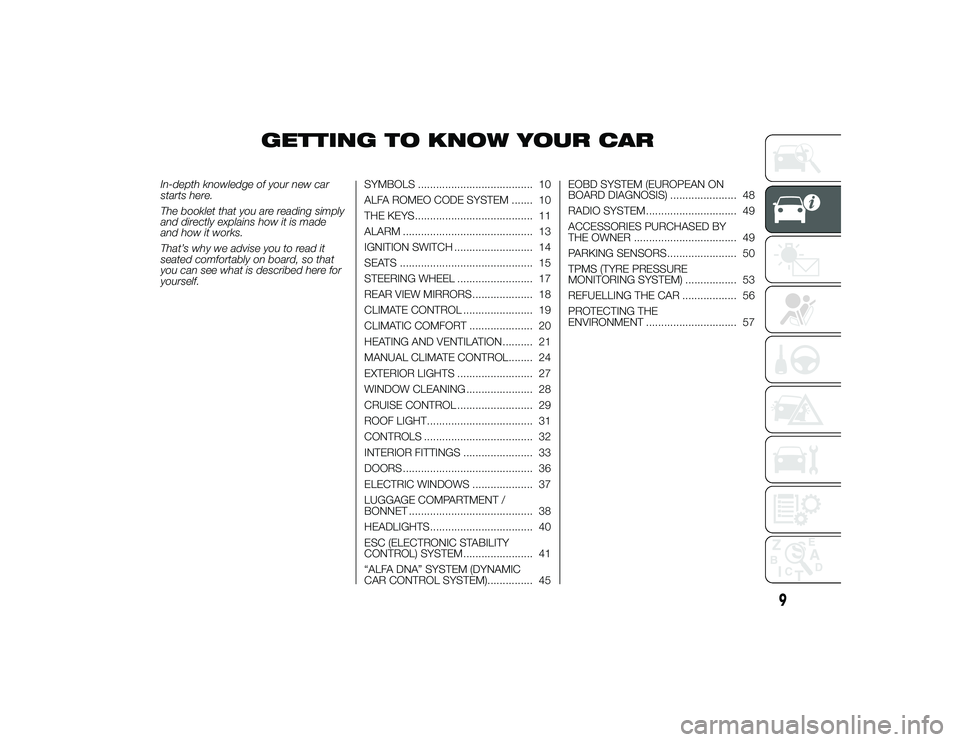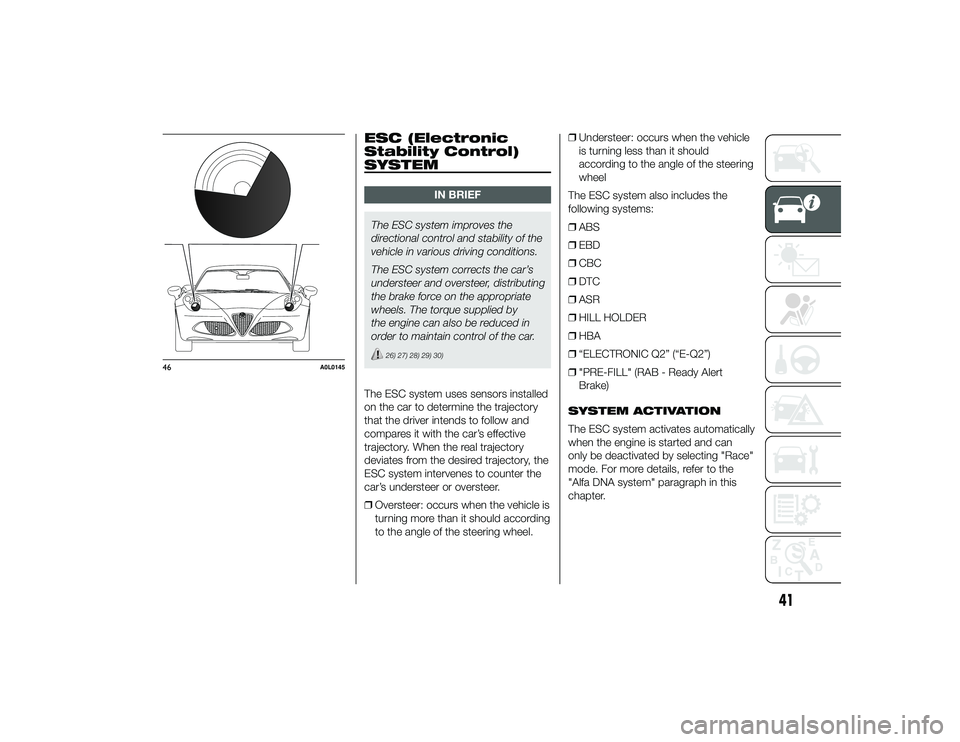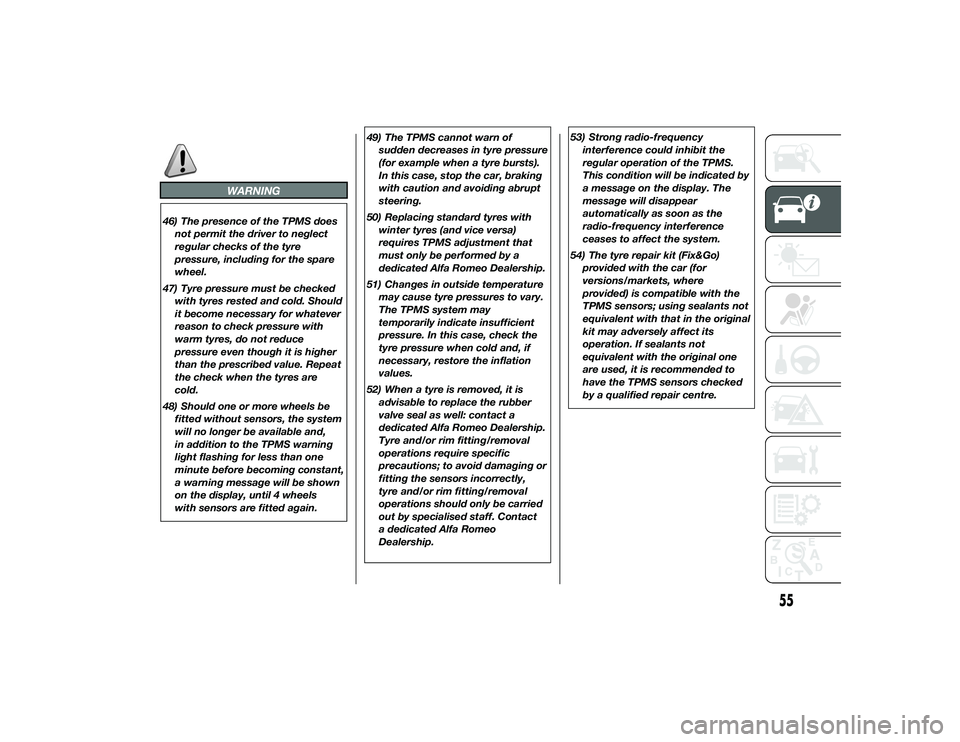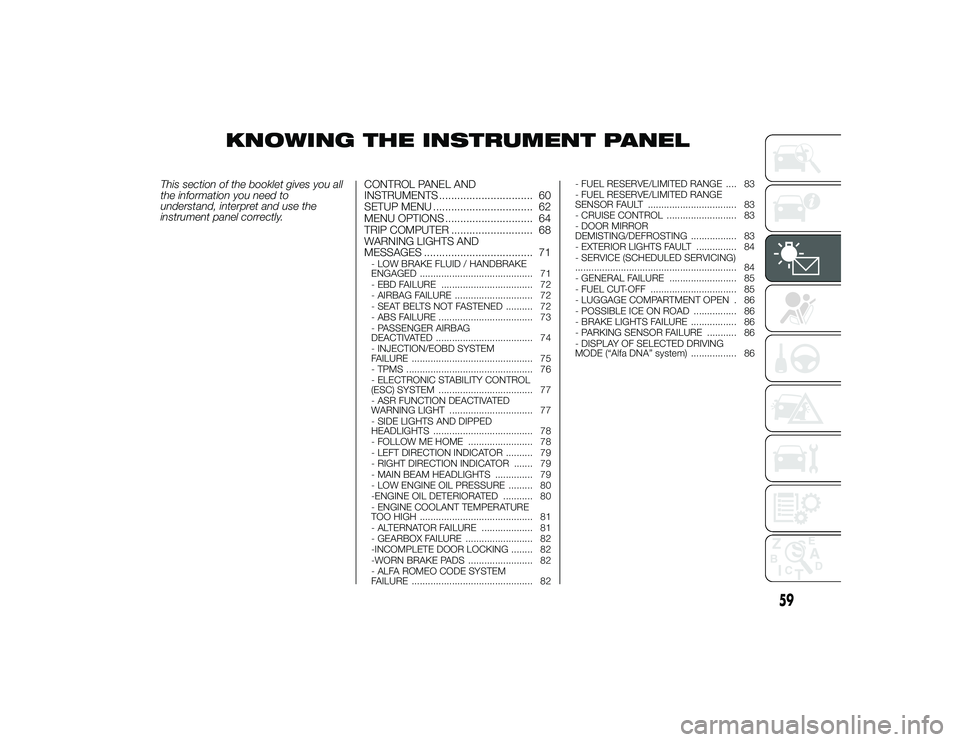sensor Alfa Romeo 4C 2013 Owner handbook (in English)
[x] Cancel search | Manufacturer: ALFA ROMEO, Model Year: 2013, Model line: 4C, Model: Alfa Romeo 4C 2013Pages: 190, PDF Size: 7.87 MB
Page 12 of 190

GETTING TO KNOW YOUR CAR
In-depth knowledge of your new car
starts here.
The booklet that you are reading simply
and directly explains how it is made
and how it works.
That’s why we advise you to read it
seated comfortably on board, so that
you can see what is described here for
yourself.SYMBOLS ...................................... 10
ALFA ROMEO CODE SYSTEM ....... 10
THE KEYS....................................... 11
ALARM ........................................... 13
IGNITION SWITCH .......................... 14
SEATS ............................................ 15
STEERING WHEEL ......................... 17
REAR VIEW MIRRORS .................... 18
CLIMATE CONTROL ....................... 19
CLIMATIC COMFORT ..................... 20
HEATING AND VENTILATION.......... 21
MANUAL CLIMATE CONTROL........ 24
EXTERIOR LIGHTS ......................... 2
WINDOW CLEANING ...................... 28
CRUISE CONTROL ......................... 29
ROOF LIGHT................................... 31
CONTROLS .................................... 32
INTERIOR FITTINGS ....................... 33
DOORS ........................................... 36
ELECTRIC WINDOWS .................... 37
LUGGAGE COMPARTMENT /
BONNET ......................................... 38
HEADLIGHTS.................................. 40
ESC (ELECTRONIC STABILITY
CONTROL) SYSTEM ....................... 41
“ALFA DNA” SYSTEM (DYNAMIC
CAR CONTROL SYSTEM)............... 45 EOBD SYSTEM (EUROPEAN ON
BOARD DIAGNOSIS) ...................... 48
RADIO SYSTEM .............................. 49
ACCESSORIES PURCHASED BY
THE OWNER .................................. 49
PARKING SENSORS....................... 50
TPMS (TYRE PRESSURE
MONITORING SYSTEM) ................. 53
REFUELLING THE CAR .................. 56
PROTECTING THE
ENVIRONMENT .............................. 57
9
24-9-2013 11:49 Pagina 9
7
Page 44 of 190

ESC (Electronic
Stability Control)
SYSTEM
IN BRIEF
The ESC system improves the
directional control and stability of the
vehicle in various driving conditions.
The ESC system corrects the car’s
understeer and oversteer, distributing
the brake force on the appropriate
wheels. The torque supplied by
the engine can also be reduced in
order to maintain control of the car.
26) 27) 28) 29) 30)
The ESC system uses sensors installed
on the car to determine the trajectory
that the driver intends to follow and
compares it with the car’s effective
trajectory. When the real trajectory
deviates from the desired trajectory, the
ESC system intervenes to counter the
car’s understeer or oversteer.
❒ Oversteer: occurs when the vehicle is
turning more than it should according
to the angle of the steering wheel. ❒
Understeer: occurs when the vehicle
is turning less than it should
according to the angle of the steering
wheel
The ESC system also includes the
following systems:
❒ ABS
❒ EBD
❒ CBC
❒ DTC
❒ ASR
❒ HILL HOLDER
❒ HBA
❒ “ELECTRONIC Q2” (“E-Q2”)
❒ "PRE-FILL" (RAB - Ready Alert
Brake)
SYSTEM ACTIVATION
The ESC system activates automatically
when the engine is started and can
only be deactivated by selecting "Race"
mode. For more details, refer to the
"Alfa DNA system" paragraph in this
chapter.
46
A0L0145
41
24-9-2013 11:49 Pagina 41
Page 53 of 190

Fiat Group Automobiles S.p.A.
authorises the installation of transceiver
devices on condition that such
installations are carried out in
a workmanlike fashion, following the
manufacturer’s instructions, at a
specialised centre.
IMPORTANT Traffic police may not
allow the car on the road if devices
have been installed which modify the
features of the car. This may also cause
invalidation of warranty in relation to
faults caused by the change either
directly or indirectly related to it.
Fiat Group Automobiles S.p.A. shall not
be liable for damage caused by the
installation of accessories either not
supplied or recommended by Fiat
Group Automobiles S.p.A. and/or not
installed in compliance with the
provided instructions.
RADIO TRANSMITTERS
AND MOBILE PHONES
Radio transmitter equipment (vehicle
mobile phones, CB radios, amateur
radio etc.) cannot be used inside the
car unless a separate aerial is mounted
on the roof.IMPORTANT The use of these devices
inside the passenger compartment
(without a separate aerial) may cause
the vehicle’s electronic systems to
malfunction. This could compromise
safety in addition to constituting a
potential hazard for passengers' health.
As far as the use of EC-approved
mobile phones is concerned (GSM,
GPRS, UMTS), follow the usage
instructions provided by the mobile
phone manufacturer.
WARNING
44) Take care when fitting additional
spoilers or non-standard alloy
wheels: they could reduce the
ventilation of the brakes and
affect efficiency in sharp,
repeated braking or on long
descents. Make sure that nothing
obstructs the pedal stroke (mats,
etc.).
PARKING SENSORS(for versions/markets, where provided)
They are located in the rear bumper
fig. 53 and their function is to detect the
presence of any obstacles near the
rear part of the car; they consequently
inform the driver, through an
intermittent acoustic signal.
ACTIVATION/
DEACTIVATION
The sensors are automatically activated
when reverse gear is engaged. As the
obstacle behind the car gets closer, the
acoustic signal becomes more
frequent.53
A0L0043
50
GETTING TO KNOW YOUR CAR
24-9-2013 11:49 Pagina 50
Page 54 of 190

ACOUSTIC SIGNAL
When reverse gear is engaged and
there is an obstacle behind the vehicle,
an acoustic signal is emitted which
varies according to the distance of the
bumper from the obstacle.
The frequency of the acoustic signal:
❒increases as the distance between
car and obstacle decreases,
culminating in a continuous acoustic
signal, when the distance is less
than approximately 30 cm;
❒ decreases if the distance from the
obstacle increases, until the signal
ceases entirely;
❒ remains constant if the distance
between car and obstacle remains
unchanged; if this situation concerns
the side sensors, the signal will
stop after approximately 3 seconds
to avoid, for example, indications
in the event of manoeuvres along a
wall.
If several obstacles are detected by the
sensors, only the nearest one is
considered. INDICATIONS ON
DISPLAY
(for versions/markets, where provided)
When the sensors are activated, the
screen in fig. 54 appears on the display.
Obstacle presence and distance
information is therefore provided both
by the acoustic signal and the
instrument panel display.
The system indicates a detected
obstacle by displaying an arc in one or
more positions according to the
distance of the obstacle and its position
in relation to the car.
If an obstacle is detected in the rear
central area, the display shows all the
arcs in the rear central area, up to
the one that corresponds to the
position of the obstacle itself.The signal is similar for obstacles in the
rear left or right area.
The arc that corresponds to the
position of the obstacle will flash.
The colour on the display depends on
the distance from and position of the
obstacle.
The car is close to the obstacle when
the display shows a single constant arc
and emits a continuous sound.
If there are several obstacles, the
closest one is indicated.
FAULT INDICATION
Parking sensor failures, if any, will be
indicated when reverse is engaged by
the switching on of the
warning
light on the instrument panel together
with the message on the display (see
“Warning lights and messages”
chapter).
GENERAL WARNINGS
45)4)
When parking, take the utmost care
over obstacles that may be above
or under the sensor.
54
A0L0044
51
24-9-2013 11:49 Pagina 51
Page 55 of 190

Under certain circumstances, objects
close to the vehicle are not detected by
the system and could therefore cause
damage to the car or be damaged
themselves.
Some conditions may influence the
performance of the parking sensors:
❒the presence of ice, snow, mud
or multiple layers of paint on the
sensor surface may cause reduced
sensitivity of the sensor itself and
therefore reduce the system
performance;
❒ mechanical interference (e.g. washing
the car, rain, strong wind, hail) may
cause the sensor to detect a
non-existent obstacle ("echo
interference");
❒ the presence of ultrasonic systems
(e.g. pneumatic brake systems of
trucks or pneumatic drills) near the
car could alter the signals sent by the
sensor;
❒ the variation in sensor position,
caused by variation in ride (due
to suspension component wear),
changing tyres, overloaded car,
or tuning that lowers the car, for
example, may affect parking sensor
system performance.
WARNING
45) The responsibility for parking
and other dangerous manoeuvres
always and in every case lies
with the driver. While carrying out
these manoeuvres, always make
sure that no people (especially
children) or animals are in the
area concerned. The parking
sensors are an aid for the driver,
but must never allow their
attention to lapse during
potentially dangerous
manoeuvres, even those executed
at low speeds.
IMPORTANT
4) The sensor must be free frommud, dirt, snow or ice in order for
the system to operate correctly.
Be careful not to scratch or
damage the sensors while
cleaning them. Avoid using dry,
rough or hard cloths. The sensors
must be washed using clean
water, with the addition of car
shampoo if necessary. When
using special washing equipment
such as high pressure jets or
steam cleaning, clean the sensors
very quickly keeping the jet more
than 10 cm away. Also, do not
apply stickers to the sensors.
52
GETTING TO KNOW YOUR CAR
24-9-2013 11:49 Pagina 52
Page 56 of 190

TPMS (Tyre
Pressure
Monitoring System)(for versions/markets, where provided)
The car can be equipped with a tyre
pressure monitoring system (TPMS),
which informs the driver of the tyre
inflation status via dedicated messages
on the display fig. 55.
The system comprises a radio-
frequency transmitter sensor fitted to
each wheel (on the rim inside the tyre),
which is able to send information on the
inflation pressure of each tyre to the
control unit.IMPORTANT
INFORMATION ABOUT
THE TPMS
46) 47) 48) 49) 50) 51) 52) 53) 54)
The fault indications are not stored and
will therefore not be displayed after
the engine has been switched off and
then on again.
If the fault conditions persist, the control
unit will send the relative indications to
the instrument panel only after the
car has been in motion for a short time.
TPMS FAILURE
In the event of TPMS failure, dashes will
be displayed instead of the tyre
pressure status together with the
activation of the dedicated
warning
light (see "Warning lights and
messages" section in the"Knowing the
instrument panel" chapter). To restore
correct operation of the system,
contact a dedicated Alfa Romeo
Dealership.
55
A0L0113
53
24-9-2013 11:49 Pagina 53
Page 57 of 190

In order to use the system properly, refer to the following table when you have to change wheels/tyres:OperationSensors on wheels fitted
on car Failure indication
Action necessary
– –YESContact a dedicated Alfa
Romeo Dealership
Wheel change with winter
tyres NO
YESContact a dedicated Alfa
Romeo Dealership
Wheel change with winter
tyres YES
NO –
Wheel change with others of
a different size (*) YES
NO –(*)Given as an alternative in the Owner Handbook as well as in the Registration Document; available from Lineaccessori Alfa Romeo.
54
GETTING TO KNOW YOUR CAR
24-9-2013 11:49 Pagina 54
Page 58 of 190

WARNING
46) The presence of the TPMS doesnot permit the driver to neglect
regular checks of the tyre
pressure, including for the spare
wheel.
47) Tyre pressure must be checked with tyres rested and cold. Should
it become necessary for whatever
reason to check pressure with
warm tyres, do not reduce
pressure even though it is higher
than the prescribed value. Repeat
the check when the tyres are
cold.
48) Should one or more wheels be fitted without sensors, the system
will no longer be available and,
in addition to the TPMS warning
light flashing for less than one
minute before becoming constant,
a warning message will be shown
on the display, until 4 wheels
with sensors are fitted again. 49) The TPMS cannot warn of
sudden decreases in tyre pressure
(for example when a tyre bursts).
In this case, stop the car, braking
with caution and avoiding abrupt
steering.
50) Replacing standard tyres with winter tyres (and vice versa)
requires TPMS adjustment that
must only be performed by a
dedicated Alfa Romeo Dealership.
51) Changes in outside temperature may cause tyre pressures to vary.
The TPMS system may
temporarily indicate insufficient
pressure. In this case, check the
tyre pressure when cold and, if
necessary, restore the inflation
values.
52) When a tyre is removed, it is advisable to replace the rubber
valve seal as well: contact a
dedicated Alfa Romeo Dealership.
Tyre and/or rim fitting/removal
operations require specific
precautions; to avoid damaging or
fitting the sensors incorrectly,
tyre and/or rim fitting/removal
operations should only be carried
out by specialised staff. Contact
a dedicated Alfa Romeo
Dealership. 53) Strong radio-frequency
interference could inhibit the
regular operation of the TPMS.
This condition will be indicated by
a message on the display. The
message will disappear
automatically as soon as the
radio-frequency interference
ceases to affect the system.
54) The tyre repair kit (Fix&Go) provided with the car (for
versions/markets, where
provided) is compatible with the
TPMS sensors; using sealants not
equivalent with that in the original
kit may adversely affect its
operation. If sealants not
equivalent with the original one
are used, it is recommended to
have the TPMS sensors checked
by a qualified repair centre.
55
24-9-2013 11:49 Pagina 55
Page 60 of 190

Emergency refuelling
If there is no fuel in the car or the supply
circuit is completely empty, proceed
as follows to reintroduce fuel to the
tank:
❒take the dedicated funnel C fig. 58
from the tool kit located in the
luggage compartment;
❒ open flap A, pulling it outwards;
❒ insert funnel C in the filler as
illustrated in fig. 58 and refuel;
❒ after refuelling, remove the funnel and
close the flap;
❒ finally, put the funnel back in its case
and put this back in the luggage
compartment.
IMPORTANT If the filler compartment is
washed with a high-pressure jet, keep
it at a distance of at least 20 cm.
WARNING
55) Do not apply any object/plug to the end of the filler which is not
provided for the car. The use
of non-compliant objects/plugs
could cause a pressure increase
inside the tank, resulting in
dangerous situations.
56) Do not bring naked flames or lit cigarettes near to the fuel tank
filler: fire risk. Avoid bringing your
face close to the filler, in order
not to breathe in harmful vapours.
57) Do not use a mobile phone near the fuel pump: risk of fire.
PROTECTING THE
ENVIRONMENTThe following devices are used for
reducing petrol fuel engine emissions:
catalytic converter, oxygen sensors and
evaporation control system.
Do not let the engine run, even for a
test, with one or more spark plugs
disconnected.
58)
WARNING
58) Under operating conditions, thecatalytic converter becomes very
hot. Therefore, do not park the car
on flammable materials (grass,
dry leaves, pine needles etc.)
to avoid the risk of fire.
57
A0L0046
58
A0L0151
57
24-9-2013 11:49 Pagina 57
Page 62 of 190

KNOWING THE INSTRUMENT PANEL
This section of the booklet gives you all
the information you need to
understand, interpret and use the
instrument panel correctly.CONTROL PANEL AND
INSTRUMENTS ............................... 60
SETUP MENU ................................. 62
MENU OPTIONS ............................. 64
TRIP COMPUTER ........................... 68
WARNING LIGHTS AND
MESSAGES .................................... 71
- LOW BRAKE FLUID / HANDBRAKE
ENGAGED .......................................... 71
- EBD FAILURE .................................. 72
- AIRBAG FAILURE ............................. 72
- SEAT BELTS NOT FASTENED .......... 72
- ABS FAILURE ................................... 73
- PASSENGER AIRBAG
DEACTIVATED .................................... 74
- INJECTION/EOBD SYSTEM
FAILURE ............................................. 75
- TPMS ............................................... 76
- ELECTRONIC STABILITY CONTROL
(ESC) SYSTEM ................................... 77
- ASR FUNCTION DEACTIVATED
WARNING LIGHT ............................... 77
- SIDE LIGHTS AND DIPPED
HEADLIGHTS ..................................... 78
- FOLLOW ME HOME ........................ 78
- LEFT DIRECTION INDICATOR .......... 79
- RIGHT DIRECTION INDICATOR ....... 79
- MAIN BEAM HEADLIGHTS .............. 79
- LOW ENGINE OIL PRESSURE ......... 80
-ENGINE OIL DETERIORATED ........... 80
- ENGINE COOLANT TEMPERATURE
TOO HIGH .......................................... 81
- ALTERNATOR FAILURE ................... 81
- GEARBOX FAILURE ......................... 82
-INCOMPLETE DOOR LOCKING ........ 82
-WORN BRAKE PADS ........................ 82
- ALFA ROMEO CODE SYSTEM
FAILURE ............................................. 82 - FUEL RESERVE/LIMITED RANGE .... 83
- FUEL RESERVE/LIMITED RANGE
SENSOR FAULT ................................. 83
- CRUISE CONTROL .......................... 83
- DOOR MIRROR
DEMISTING/DEFROSTING ................. 83
- EXTERIOR LIGHTS FAULT ............... 84
- SERVICE (SCHEDULED SERVICING)
............................................................ 84
- GENERAL FAILURE ......................... 85
- FUEL CUT-OFF ................................ 85
- LUGGAGE COMPARTMENT OPEN . 86
- POSSIBLE ICE ON ROAD ................ 86
- BRAKE LIGHTS FAILURE ................. 86
- PARKING SENSOR FAILURE ........... 86
- DISPLAY OF SELECTED DRIVING
MODE (“Alfa DNA” system) ................. 86
59
24-9-2013 11:49 Pagina 59